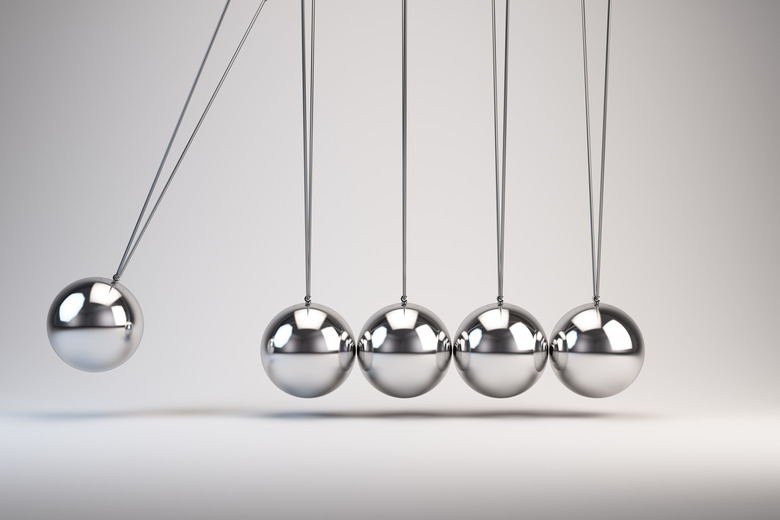The Factors That Might Affect The Period Of Oscillation
In physics, a period is the amount of time required to complete one cycle in an oscillating system such as a pendulum, a mass on a spring or an electronic circuit. In one cycle, the system moves from a starting position, through maximum and minimum points, then returns to the beginning before starting a new, identical cycle. You can identify the factors that affect the period of oscillation by examining the equations that determine the period for an oscillating system.
The Swinging Pendulum
The Swinging Pendulum
The equation for the period (T) of a swinging pendulum is:
\(T=2\pi \sqrt{\frac{L}{g}}\)
where π (pi) is the mathematical constant, L is the length of the arm of the pendulum and g is the acceleration of gravity acting on the pendulum. Examining the equation reveals that the period of oscillation is directly proportional to the length of the arm and inversely proportional to gravity; thus, an increase in the length of a pendulum arm results in a subsequent increase in the period of oscillation given a constant gravitational acceleration. A decrease in length would then result in a decrease in the period. For gravity, the inverse relationship shows that the stronger the gravitational acceleration, the smaller the period of oscillation. For example, the period of a pendulum on Earth would be smaller compared to a pendulum of equal length on the moon.
Mass on a Spring
Mass on a Spring
The calculation for the period (T) of a spring oscillating with a mass (m) is described as:
\(T=2\pi \sqrt{\frac{m}{k}}\)
where pi is the mathematical constant, m is the mass attached to the spring and k is the spring constant, which is related to a spring's "stiffness." The period of oscillation is, therefore, directly proportional to the mass and inversely proportional to the spring constant. A stiffer spring with a constant mass decreases the period of oscillation. Increasing the mass increases the period of oscillation. For example, a heavy car with springs in its suspension bounces more slowly when it hits a bump than a light car with identical springs.
Wave
Wave
Waves such as ripples in a lake or sound waves traveling through the air have a period equal to the reciprocal of the frequency; the formula is:
\(T=\frac{1}{f}\)
where T is the time period of oscillation and f is the wave's frequency, usually measured in hertz (Hz). When a wave's frequency increases, its period decreases.
Electronic Oscillators
Electronic Oscillators
An electronic oscillator generates an oscillating signal using electronic circuitry. Because of the great variety of electronic oscillators, the factors that determine the period depend on the circuit design. Some oscillators, for example, set the period with a resistor connected to a capacitor; the period depends on the resistor's value in ohms multiplied by the capacitance in farads. Other oscillators use a quartz crystal to determine the period; because quartz is very stable, it sets an oscillator's period with great precision.
Cite This Article
MLA
Perdue, Matthew. "The Factors That Might Affect The Period Of Oscillation" sciencing.com, https://www.sciencing.com/factors-might-affect-period-oscillation-8437461/. 13 December 2020.
APA
Perdue, Matthew. (2020, December 13). The Factors That Might Affect The Period Of Oscillation. sciencing.com. Retrieved from https://www.sciencing.com/factors-might-affect-period-oscillation-8437461/
Chicago
Perdue, Matthew. The Factors That Might Affect The Period Of Oscillation last modified August 30, 2022. https://www.sciencing.com/factors-might-affect-period-oscillation-8437461/
